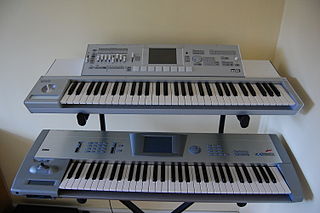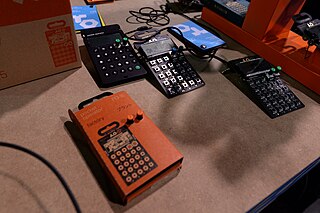
Cubase is a digital audio workstation (DAW) developed by Steinberg for music and MIDI recording, arranging and editing. The first version, which was originally only a MIDI sequencer and ran on the Atari ST computer, was released in 1989. Cut-down versions of Cubase are included with almost all Yamaha audio and MIDI hardware, as well as hardware from other manufacturers. These versions can be upgraded to a more advanced version at a discount.
Steinberg Media Technologies GmbH is a German musical software and hardware company based in Hamburg. It develops music writing, recording, arranging, and editing software, most notably Cubase, Nuendo, and Dorico. It also designs audio and MIDI hardware interfaces, controllers, and iOS/Android music apps including Cubasis. Steinberg created several industry standard music technologies including the Virtual Studio Technology (VST) format for plug-ins and the ASIO protocol. Steinberg has been a wholly owned subsidiary of Yamaha since 2005.

Virtual Studio Technology (VST) is an audio plug-in software interface that integrates software synthesizers and effects units into digital audio workstations. VST and similar technologies use digital signal processing to simulate traditional recording studio hardware in software. Thousands of plugins exist, both commercial and freeware, and many audio applications support VST under license from its creator, Steinberg.

A digital audio workstation (DAW) is an electronic device or application software used for recording, editing and producing audio files. DAWs come in a wide variety of configurations from a single software program on a laptop, to an integrated stand-alone unit, all the way to a highly complex configuration of numerous components controlled by a central computer. Regardless of configuration, modern DAWs have a central interface that allows the user to alter and mix multiple recordings and tracks into a final produced piece.

The Korg Triton is a music workstation synthesizer, featuring digital sampling and sequencing, released in 1999. It uses Korg's HI Synthesis tone generator and was eventually available in several model variants with numerous upgrade options. The Triton became renowned as a benchmark of keyboard technology, and has been widely featured in music videos and live concerts. At the NAMM 2007, Korg announced the Korg M3 as its successor.
Reaktor is a graphical modular software music studio developed by Native Instruments (NI). It allows musicians and sound specialists to design and build their own instruments, samplers, effects and sound design tools. It is supplied with many ready-to-use instruments and effects, from emulations of classic synthesizers to futuristic sound design tools. In addition, more than 3000 free instruments can be downloaded from the growing User Library. All of Reaktor's instruments can be freely examined, customized or taken apart; Reaktor is a tool that effectively encourages reverse engineering. The free, limited version called Reaktor Player is software that allows musicians to play NI-released Reaktor instruments, but not edit or reverse-engineer them.

Logic Pro is a proprietary digital audio workstation (DAW) and MIDI sequencer software application for the macOS platform developed by Apple Inc. It was originally created in the early 1990s as Notator Logic, or Logic, by German software developer C-Lab which later went by Emagic. Apple acquired Emagic in 2002 and renamed Logic to Logic Pro. It is the second most popular DAW – after Ableton Live – according to a survey conducted in 2015.
Arturia is a French electronics company founded in 1999 and based in Grenoble, France. The company designs and manufactures audio interfaces and electronic musical instruments, including software synthesizers, drum machines, analog synthesizers, digital synthesizers, MIDI controllers, sequencers, and mobile apps.
Reason Studios is a music software company, based in Stockholm, Sweden, and founded in 1994. It produces the studio emulation Reason.
Kontakt is Native Instruments' flagship software sampler and one of the leading software sampling applications on the market.

Nuendo is a digital audio workstation (DAW) developed by Steinberg for music recording, arranging, editing and post-production. The package is aimed at audio and video post-production market segments, but also contains optional modules that can be used for multiple multimedia creation and audio sequencing.
Loopmasters is an English sound design record label based in Brighton, England. Loopmasters is mainly known for releasing and publishing sample packs on the pro-audio market and cooperating with software and hardware vendors including Ableton Live and Focusrite. Since 2008 Loopmasters also functions as an online store for music composers, and computer-based DAWs like Steinberg Cubase, Apple Logic, Propellerheads Reason or Ableton Live. The record label is known for releasing samples of performers, producers and DJs such as Deadmau5, Rezone, Coldcut, Full Cycle, Mad Professor, Meat Katie, Histibe, Todd Terry, Ray Keith, DJ Pierre etc.

Audio Random Access is an extension for audio plug-in interfaces, such as AU, VST and RTAS, allowing them to exchange a greater amount of audio information with digital audio workstation (DAW) software. It was developed in a collaboration between Celemony Software and PreSonus.

Vienna Symphonic Library GmbH (VSL) is a developer of sample libraries and music production software for classical orchestral music. The company is located in a landmark protected building, called Synchron Stage Vienna based in the Austrian capital's 23rd district.

Studio One is a digital audio workstation (DAW) application, used to create, record, mix and master music and other audio, with functionality also available for video. Initially developed as a successor to the KRISTAL Audio Engine, it was acquired by PreSonus and first released in 2009 for macOS and Microsoft Windows.

A bedroom producer is an amateur musician who creates, performs, and records their music independently using a home studio, often considered a hobbyist opposed to a professional record producer in the recording industry that works in a traditional studio with clients. Typically bedroom producers use accessible digital technology that costs less than the equipment in a professional studio, such as MIDI controller-based instruments and virtual studio technology, to create music for release to the world. While a professional record producer oversees and guides the recording process, often working alongside multiple people such as studio musicians, singers, engineers, mixers, songwriters, arrangers, and orchestrators, a bedroom producer does everything independently: creating the ideas, recording them and processing them for release. Bedroom producers are often self-taught, learning sound design, mixing and music theory by reading music production blogs and watching tutorials on the internet. As bedroom producers depend on the accessibility of music technology, bedroom production has been made easier with advances in home computing power and digital audio workstations (DAW).

Karl "Charlie" Steinberg is a German businessman best known for being the co-founder of Steinberg Media Technologies in 1983 with Manfred Rürup. Their tools helped to make digital audio editing popular, most notably through the Cubase program. Together with Manfred Rürup, they also co-founded the now-discontinued online service digitalmusician.net.

The Volca Beats is a hybrid drum machine produced by the Japanese music technology manufacturer Korg. It was released in April 2013 along with the Volca Keys and Volca Bass. The Beats uses both analogue synthesis and PCM samples to produce drum sounds.

Pocket Operators are a line of miniature synthesizers, drum machines and grooveboxes, produced by the Swedish manufacturer Teenage Engineering. They were originally released in 2015 as a collaborative effort with the clothing brand Cheap Monday before they went bust. They are inexpensive, with all main line models retailing for under $100. As of 2022, there are nine models in the main series, along with four limited edition models and an app.













